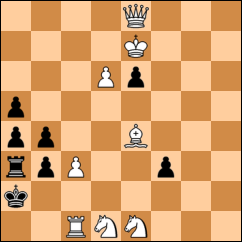#3 b) Ne1>b2 c)=b+Nd1>c4
Daniel Perone
Especial Honorable Mencion MT Tomas Salamanca
a) Diagram
1. Qg8? 1. … f2! ; 1.Qg6? 1. … e5!
1. Qf7!
1. … e5 2. Nc2 ad lib 3.Ra1#
1. … bxc3 2.Nxc3+Kb2 3.Nd3#
1. … f2 2.Qxf2+ b2 3.Qxb2#
1. … b2 2.Bb1+Ka1 3.Nc2#
2. … Kb3 3.Qxe6#
b) Ne1>b2
1. Qg6? / 1.Bd5? /Bh7? 1. … e5!; 1.Kxe6? 1. … f2!
1. Qb5!
1. … e5/f2 2.Qd3 ad lib 3.Qb1#
1. … bxc3 2.Rb1 ad lib 3.Nxc3#
c)=b+Nd1>c4
1. Qg6? bxc3!
1. Qh5!
1. … bxc3 2Qc5 ad lib 3.Qxa3#
1. … e5 2.Qh1 ad lib 3.Ra1#
1. … f2 2.Qd1 ad lib 3.Ra1#
Black’s structure is similar to A. Sygurov’s problem (# 4 JT100 H. Musante), but this configuration has the slogan of # 3, with twins and several different mates.

